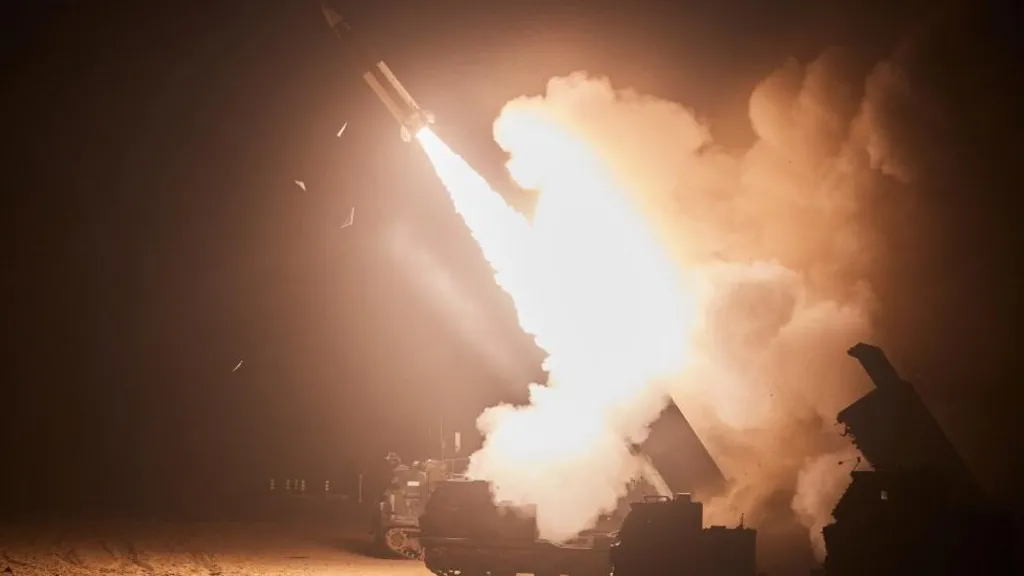This article is more than
8 year oldItaly quake: Thousands spend night in temporary accommodation
The 6.6-magnitude quake - Italy's strongest in decades - struck close to the region where nearly 300 people were killed by a quake in August.
This time no-one appears to have died, but about 20 people were injured.
Powerful aftershocks are still bringing down masonry.
In the town of Norcia, in Perugia region, close to the epicentre of Sunday morning's earthquake, some locals have decided to stay in their homes.
Others will spend the night in tents pitched near the town or are taking up the authorities' offer of shelter on the Adriatic Coast.
"It will be a difficult night," the head of Italian Civil Defence, Fabrizio Curcio. "A 6.5 earthquake has clearly changed the situation."
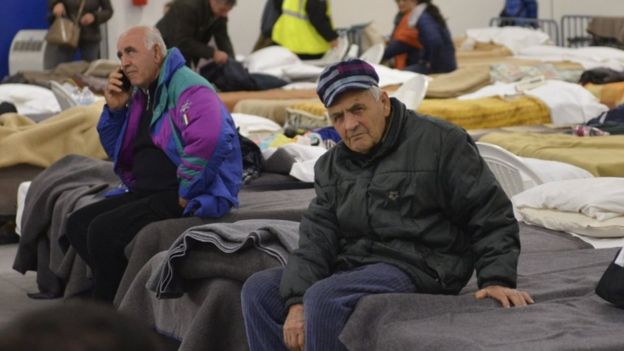
Locals are spending the night in temporary accommodation
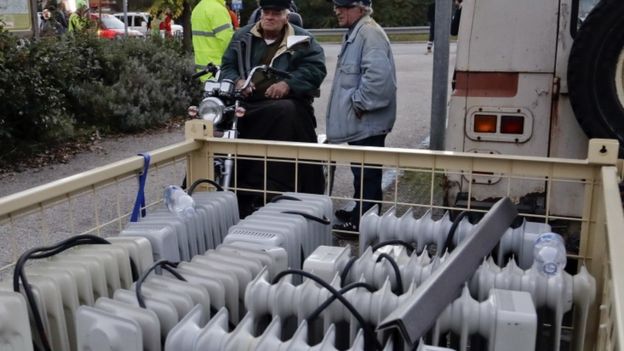
Electric heaters have been taken to the affected areas
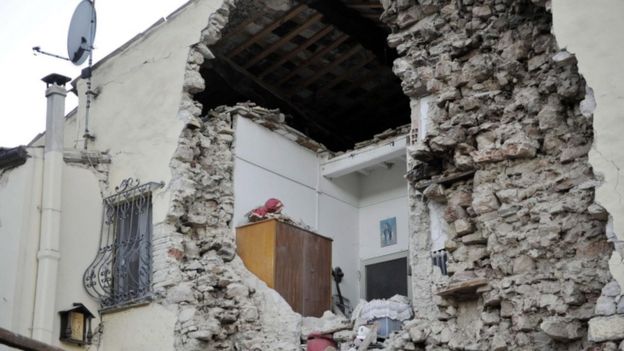
Image captionBuildings have been destroyed or badly damaged but no deaths have been reported
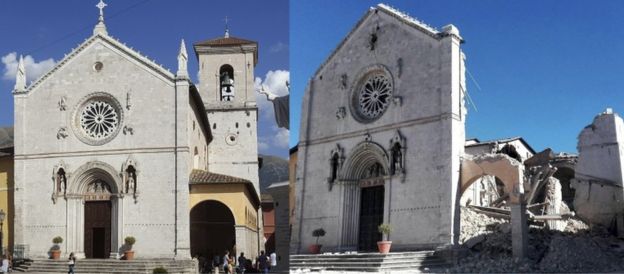
The 14th century Cathedral of St Benedict was among the historic sites hit
Norcia resident Stefano Boldrini, who is now living in a van with his eight-year-old daughter, was asked if they planned to stay in the area.
"No, how could we? There's no more school, or church, or police station. There's nothing here any more," he said.
The medieval basilica of St Benedict in Norcia was among many historic buildings and structures that were destroyed.
An evacuation of buildings in central Italy deemed vulnerable to seismic activity last week, following strong aftershocks from August's quake, may have saved lives.
Officials said three people were dug out of the rubble alive in the town of Tolentino.
Giuseppe Pezzanesi, mayor of Tolentino, said the small town had "suffered our blackest day yet.
"The damage is irreparable. There are thousands of people in the streets, terrified, crying. Let's hope that is an end to it, the people are on their knees psychologically."
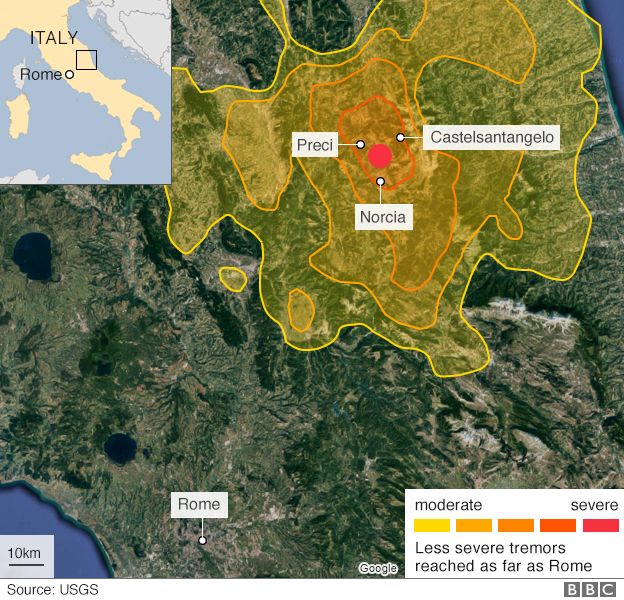
The towns of Castelsantangelo and Preci have also suffered considerable damage, but were mainly abandoned after last week's quakes, of magnitude 5.5 and 6.1.
Castelsantangelo's mayor, quoted by La Stampa newspaper, said there were no casualties at all in the town as "everyone had already left".
The mayors of the villages of Ussita and Arquata reported that many buildings had collapsed there too.
Tremors from this latest earthquake were felt in the capital Rome, where the Metro system was shut down, and as far away as Venice in the north.
Why multiple quakes are hitting Italy - by Jonathan Amos, BBC science correspondent
We have now seen three magnitude-6 tremors in Italy's Apennines region in just three months.
The big picture is reasonably well understood. Wider tectonic forces in the Earth's crust have led to the Apennines being pulled apart at a rate of roughly 3mm per year - about a 10th of the speed at which your fingernails grow.
But this stress is then spread across a multitude of different faults that cut through the mountains. And this network is fiendishly complicated.
It does now look as though August's event broke two neighbouring faults, starting on one known as the Laga and then jumping across to one called the Vettore.
The mid-week tremors appear to have further broken the northern end of the Vettore. But both in August and mid-week, it seems only the top portions of the faults have gone, and the big question is whether the deeper segments have now failed in the latest event.
Prime Minister Matteo Renzi has promised that everything will be rebuilt, saying resources will be found.
"We are going through a really tough period," he said. "We must not allow the profound pain, fatigue and stress that we have now to turn into resignation."
Central Italy has seen several major quakes in recent years. Earthquakes which devastated the town of L'Aquila in 2009 and Amatrice in August this year killed about 300 people each.
But they both measured only 6.2 and were deeper than Sunday's earthquake.
Italy's most violent earthquakes since 1900
- October 2016 - Norcia, central Italy, magnitude 6.6, no deaths reported so far
- November 1980 - Campania, southern Italy (Naples badly hit), magnitude 6.9, up to 5,000 killed
- July 1930 - Irpinia, Campania, magnitude 6.6, 1,400 killed
- January 1915 - L'Aquila, magnitude 6.7, more than 30,000 killed
- December 1908 - Strait of Messina, magnitude 7.1, up to 200,000 killed by earthquake and tsunami
- September 1905 - Calabria, magnitude 7.2, up to 2,500 killed by tsunami
Keywords
<p>Ukraine has begun using longer-range ballistic missiles against Russia that were secretly provided by the US, American officials have confirmed.</p>
China warns relations with US could slip into ‘downward spiral’ if red lines crossed
King’s Funeral Plans Dusted Off—as Health Remains a Mystery
Here’s why Iran decided not to attack Israel again
Megan Thee Stallion’s Ex-Makeup Guru Talks. It’s Not Pretty.
KANYE WEST PLANS TO LAUNCH 'YEEZY PORN' ... Could Be Coming Soon!!!
Can Zendaya make the leap from tween idol to Hollywood heavyweight?
Bill Maher's audience roars with laughter after he mocks Don Lemon to his face
Trump lawyer tells SCOTUS that president could have immunity after ordering military to assassinate a political rival
MAJOR ANNOUNCEMENT: Buck Palace updates on King Charles’ condition




